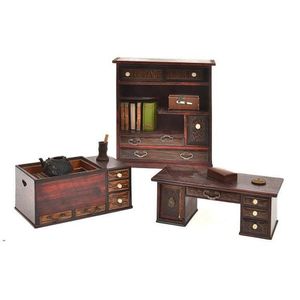Victorian Burr Walnut Credenza with Marble Top
You must be a subscriber, and be logged in to view price and dealer details.
Subscribe Now to view actual auction price for this item
When you subscribe, you have the option of setting the currency in which to display prices to $Au, $US, $NZ or Stg.
- Serpentine - Resembling a serpent, in the form of an elongated 'S'. A serpentine front is similar to a bow front, except that the curve is shallow at each end, swelling towards the middle. The term presumably derives from its similarity to a moving snake or serpent. Serpentine fronts are usually veneered, with the carcase either being cut and shaped from a solid piece of timber, or built in the 'brick' method.
- Burr - Burr (or in the USA, burl) is the timber from the knotted roots or deformed branch of the tree, which when cut, displays the small circular knots in various gradations of colour. It is always cut into a decorative veneer, most commonly seen as burr walnut on 19th century furniture.
- Plinth - The square or rectangular base of a piece of cabinet furniture, often ornamented with moulding. The plinth may be separate, as in some wardrobes or presses, and act as the support for the carcase. In a false plinth, the moulded boards may be attached directly to the piece. Furniture with a plinth base usually does not have separate feet. The term derives from architecture where it denotes the base of a column or statue.
- Pierced Decoration - Ornamental woodwork with part of the background cut through and removed to produce an open-work pattern.
- Victorian Period - The Victorian period of furniture and decorative arts design covers the reign of Queen Victoria from 1837 to 1901. There was not one dominant style of furniture in the Victorian period. Designers used and modified many historical styles such as Gothic, Tudor, Elizabethan, English Rococo, Neoclassical and others, although use of some styles, such as English Rococo and Gothic tended to dominate the furniture manufacture of the period.
The Victorian period was preceded by the Regency and William IV periods, and followed by the Edwardian period, named for Edward VII (1841 ? 1910) who was King of the United Kingdom and the British Dominions and Emperor of India for the brief period from 1901 until his death in 1910.
This item has been included into following indexes:
Visually similar items

A Victorian marble topped rosewood credenza, mid 19th century. of demi-lune serpentine profile, having an arched glass with carved and pierced fruiting and floral forms, a white marble top and three cupboards below with a mirrored central medallion flanked

A mid-Victorian marble-topped burr walnut and inlaid side cabinet, 1870s, of serpentine outline, the veined white marble top with a shaped and foliate-crested mirrored back above three cabinet doors, each with an arched mirrored panel, on a plinth base and

Three Japanese Meiji Chinese dolls house furniture pieces and accessories

Tropical Klapp camera No. 820493 European; 10 x 15 cm., polished wood-body, tan-leather coloured bellows and viewing hood, with a Carl Zeiss, Jena Tessar F/4.5 16.5 cm. Lens No. 169520, condition: 6; lacks Viewing screen, Shutter Defective
